Top News
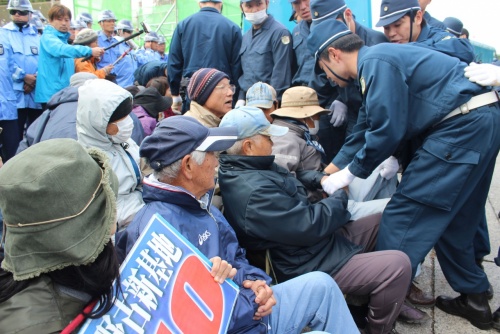
January 18, 2016 Ryukyu Shimpo
In the early morning on January 18, about 80 citizens gathered in front of Camp Schwab’s gate to protest construction of the replacement facility for U.S. Marine Corps Air Station Futenma in Henoko, Nago. Between 7 a.m. and 9:20 a.m., riot police officers removed the citizens who were sit-in protesting, allowing at least nine vehicles related to construction, including concrete mixers and trucks hauling stone, to enter the compound of Camp Schwab through the gate.
Kimio Oda, a former member of Japan Self-Defense Forces, visited the front of the gate. He stated that the sit-in is becoming a bulwark against militarism. If the number of those sitting in at Camp Schwab’s gate does not increase, he anticipates difficulty bringing a halt to warmongering. He calls for others to spread this message throughout Japan.
Meanwhile, no construction operations related to the relocation facility have been observed on Oura Bay.
(English translation by T&CT and Erin Jones)
Go to Japanese
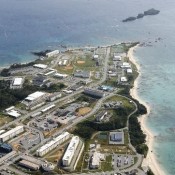
January 15, 2016 Ryukyu Shimpo
Okinawa Prefectural Government (OPG) decided to launch an additional court case on January 14 against the national government over the issue of Futenma Air base relocation to Henoko in Nago City. The case is to file complaints about the decision made by the third group, Central and Local Government Dispute Management Council, to have rejected Governor Onaga’s request to examine the conclusion about the issue announced by the Ministry of Land, Infrastructure, Transportation and Tourism.
The complaint is to announce dissatisfaction with the conclusion based on the Local Autonomy Act. Currently, both national and prefectural governments are filing court cases against each other, and this additional court case will be the third case on the Henoko issue being held at the same time.
Governor Onaga and members at OPG were set to discuss and make an official decision on January 15. The prefecture will precede with the process in order to meet a February 3 deadline held by the Council in order to file an action at the high court.
(English translation by T&CT and Sayaka Sakuma)
Go to Japanese
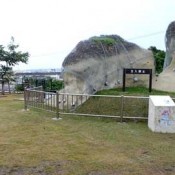
January 12, 2016 Ryukyu Shimpo
Yamashita Town First Cave Ruin is known as one of the oldest ruins of the Paleolithic period. Naha City government completed a project to renovate the cave and made it a park. An inauguration ceremony was held in Yamashita Town, Naha, on January 8. Based on a rocky stretch where a human bone 32,000 years old was found, the new park is expected to provide an opportunity for study and tourism.
The cave is about 1.2 meters in width, about 3 meters high, and about 5 meters in depth. It was found in 1962. The second excavation team unearthed tools made of the horns and bones of deer. The bone of a female infant who is presumed to have been eight years old when she died was also discovered. The infant was named Yamashita Cave Person. In 1969, the then Ryukyu government designated the area a historic site, and it is currently designated as such by the Okinawa Prefectural Government.
The new park is about 900 square meters in size. By purchasing private land, the city government worked on the project to renovate it. The project cost about 100 million yen. The park is equipped with toilets, benches, fitness equipment, and a space that can park two cars.
Local residents attended the ceremony. Naha City Mayor Mikiko Shiroma said in speech, “I pray for the park to be loved by the local citizens and provide a place for exchange.” Naha City Assembly member Toru Kinjo said, “It is rare for ruins to become a park.” Kinjo expected the park to be effectively used.
In the ceremony, nursery school toddlers performed a dance and an explanation about the ruins was provided by the city staff.
(English translation by T&CT)
Go to Japanese
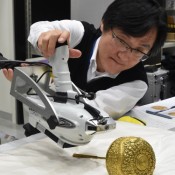
January 15, 2016 Ryukyu Shimpo
From January 12, using state-of-the-art equipment, Okinawa Prefectural Museum & Art Museum has been carrying out X-ray examinations of more than 50 pieces of crafts made during the Ryukyu Kingdom era.
On January 14, the museum disclosed the examination process to the news media. The examination aims to reveal the materials and manufacturing processes of pottery, gold works, and ceramics of the period. It is the first time in Okinawa to examine crafts stored in museums. The museum aims to exhibit restored crafts in 2019.
On January 14, a cultural asset of Okinawa Prefecture, a golden hairpin of Kikoe ookimi udun was examined. The hairpin was gilded with a mixture of gold, silver and bronze. About 20 items had been examined by January 15.
With the support of Tokyo Research Institute for Cultural Properties, the examination has been conducted with the most advanced equipment and specialists. Using the characteristic of the X-ray in which its reflection varies depending on radiated materials, the researchers analyzed the contents and dyes of the crafts.
A benefit of doing the X-ray examination includes finding materials without breaking or scraping the cultural properties. Based on the fundamental data collected from the examination, researchers analyzed colorants and manufacturing processes.
The restoring projects include war-damaged cultural properties such as Nio of Enkakuji Temple.
(English translation by T&CT and Megumi Chibana)
Go to Japanese
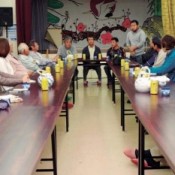
January 14, 2016 Ryukyu Shimpo
The Ministry of Defense (MOD) has proposed Hirae within Ishigaki City as the planned site for deployment of Japan Self Defense Forces (JSDF). On the night of January 13, about 20 resident representatives of the neighboring districts of Kainan, Takeda, and Omoto gathered at Omoto Citizens’ Public Hall. Those gathered decided to jointly oppose and protest the deployment plan. The MOD proposed to have a meeting for exchanging ideas with local residents on January 20, but the representatives of the districts have decided to boycott the meeting.
The three districts’ representatives’ choice was not to officially declare acceptance or opposition of the JSDF deployment itself. Rather, they chose to oppose base construction at the proposed site. Since the MOD proposed the plan while offering no explanation to local residents, the representatives concluded a declaration of their opposition and will submit it to the Ishigaki City government on January 15.
Members of the MOD are trying to organize the January 20 meeting between local residents and Ministry for an opportunity to explain the plan. Local representatives have said that holding the meeting at all is unnecessary.
Tetsuhiro Kinjyo, director of Takeda Citizens’ Public Hall, mentioned that local residents were raising their voices to ask if a unilateral plan by the MOD, without any input by involved parties, is really acceptable. He emphasized that if local representatives do not act in accordance with residents’ opposition to the MOD’s plan, then the situation will become serious.
(English translation by T&CT and Erin Jones)
Go to Japanese
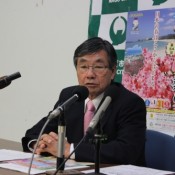
January 13, 2016 Ryukyu Shimpo
At a press meeting on January 13, Nago mayor Susumu Inamine criticized recent remarks made by Prime Minister Shinzo Abe at a national Diet session. The prime minister said that matters of national security “are not something decided by a single local election.” In response to this, Mayor Inamine stated, “Just because defense matters are decided at the national level, that doesn’t mean it is acceptable to ignore local [wishes] and proceed [with the base relocation].” The Henoko area of Nago is the planned relocation site for U.S. Marine Corps Air Station (MCAS) Futenma. “The hardline stance of the current administration is evident [from the Prime Minister’s remark],” Inamine added.
Mayor Inamine pointed out that the relocation of MCAS Futenma is a major issue at stake in the Ginowan mayoral election, for which voting will commence on January 24. The election “will have crucial implications for the future of Nago as well,” the mayor stated. He expressed hope for the candidate opposing the Henoko relocation, saying, “If the prefectural governor, the mayor of Ginowan, and the mayor of Nago are unanimous [in opposing the relocation], it will add power to the movement to stop the relocation.”
Chief Cabinet Secretary Yoshihide Suga has expressed support for the incumbent Ginowan mayor’s idea to try to bring a Disney-themed resort to Ginowan. Mayor Inamine was critical of this as well, saying, “It is nothing but a pipe dream conjured up as a way to win votes in the election.”
(Translation by T&CT and Sandi Aritza)
Go to Japanese
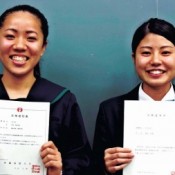
January 10, 2016 Ryukyu Shimpo
By Manato Akira
Last June, a “Free Cram School” initiative targeting high school students from economically deprived families opened its doors to the public in Okinawa City. There has already been news of students getting accepted to their first-choice schools through entrance examinations, such as the selected student screening. Among this batch of students are 18-year olds Suzuna Nakamura and Arisa Chibana. Nakamura, a junior at Maehara Senior High School, was accepted to the University of the Ryukyus, while Chibana, a junior at Okinawa Prefectural Koza High School, was accepted to Okinawa International University. “It’s meaningful to have the Free Cram School in central Okinawa, where there is a particularly high concentration of poor families,” said Tsukasa Yamashiro, their teacher at Shogakuin Cram School.
He added, ”Exams for selected candidates and Admissions Office (AO) exams require special ways of preparing. As a selected candidate, students need to receive the school’s recommendation. For AO, universities will look into the students’ qualities to see if they match with the student persona they are looking for.” Both students agreed, “If we didn’t have the Free Cram School, we wouldn’t have been able to pass our exams.”
Nakamura had always wanted to attend university. However, she deemed it impossible to take any college preparation courses, thinking of the financial burden it would cause on her single-parent household. When she learned about the Free Cram School, she didn’t think twice before signing up. Nakamura continued her part-time job to financially support her family, on top of preparing for both the general entrance exam and the selected candidates exam. Next year, she will begin her undergraduate studies at the University of the Ryukyus. She has secured herself a spot in the Industry Management Department at the Faculty of Tourism and Industrial Management. “I want to continue working part-time and pursue my studies in management and languages. I’m really excited,” she says, her eyes full of hope. Her long-term goal is to start her own company with great working conditions for its employees.
Chibana registered for the Free Cram School after she read about it in a newspaper advertisement. “If it wasn’t for free, there was no way I could have attended a cram school,” she said. She prepared for her entrance exams in parallel to committing to softball practice, which took her team all the way to the Kyushu Competitions. Having watched her parents undergo employment struggles, she began to question the unstable job market in Okinawa.
Naturally, she decided to major in Economics. “I want to help improve the economy in Okinawa, even if it’s a tiny step,” she stated. After university, she hopes to become a high school teacher who can nurture the next generation of Okinawans.
The “Free Cram School” began as part of the prefectural government’s “Comprehensive Support Model Project for Child-Rearing”. Naha Shogakuin was entrusted with the management. Of the 21 students who registered, a noteworthy 81 percent have received acceptances from universities. In addition, Okinawa Shogakuin began holding its Free Cram School this fiscal year, giving high school students in central Okinawa a chance to attend. Of the 13 students enrolled, five have been accepted to their first-choice school.
Yamashiro at Shogakuin comments, “Poverty transmits from one generation to another. We can’t simply blame ourselves for making our children live in poverty and leave it at that. It’s important for the government to allocate funding where necessary. I hope more measures will be seen at the municipal level to help students get into college.”
(Translation by T&CT, Kaya Doi)
Go to Japanese
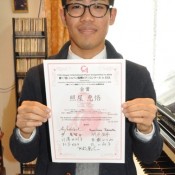
January 11, 2016 Ryukyu Shimpo
The 17th International Chopin Piano Competition in Asia took place on January 8 in Yokohama. Keigo Teruya, a 19-year-old freshman student at Okinawa Prefectural University of Arts whose hometown is Nanjo City, Okinawa, won first-prize in the university division. There were 24 competitors in this division. Teruya said enthusiastically that he performed to the best of his ability and feels a sense of accomplishment.
At the competition, Teruya played the Japanese etude Kogarashi and Chopin’s Scherzo no. 4. He was satisfied with how the tune of the piano was suited to the concert hall’s acoustics, saying that this helped him display his talents.
Teruya claimed that he practices piano about five hours a day at his university. He says, “Of course I like Chopin, and I also like German composers like Bach and Beethoven.” In the future he hopes to study abroad.
Even from the time he was a high school student in Haebaru Town, Teruya has won first place in competitions time after time. He was ranked first in a music competition as recently as November last year. On January 23 he will do a free-admission musical showcase titled Chopin at Haebaru Cultural Center.
(English translation by T&CT and Erin Jones)
Go to Japanese
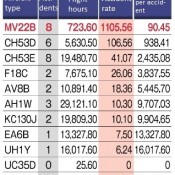
January 12, 2016 Ryukyu Shimpo
Sakae Toiyama reports from Washington, D.C.
Recent statistics show that during fiscal 2010-2012, the U.S. Marine Corps’ MV-22 Osprey aircraft stationed in Afghanistan experienced one Class A-D accident for every 90.4 hours of flight time. The MV-22 Osprey is a tiltrotor vertical/short takeoff and landing (VSTOL). In comparison, the average rate of accidents for all U.S. Marine Corps aircraft stationed in Afghanistan was one accident for every 3746.8 hours of flight time. This puts the Osprey’s accident rate at more than 40 times the average.
When looking at the rate of accidents per 100,000 flight hours, the average for all aircraft was 26.69 accidents, while for the Osprey it reached 1105.56 accidents. These statistics were revealed in an accident report for U.S. Marine Corps aircraft published on January 10 by the U.S. Naval Safety Center. The numbers, showing a comparatively high rate of Osprey accidents, have come to light at a time when concerns about the Osprey’s safety are already prevalent.
According to the report, Osprey flight time in Afghanistan has reached 723.6 hours. The CH-53E, another aircraft, has totaled 19,480.7 hours, while the CH-53D has reached 5630.5 hours. The Osprey is considered the Marines’ key aircraft, but its flight hours are drastically fewer than those of other aircraft.
A total of eight Class A-D Osprey accidents have occurred in Afghanistan. Of those, one was a Class A accident, the most severe type involving fatalities or a loss of $2 million or more. The other seven were Class C accidents, which involve non-fatal injuries or a loss of between $50,000 and $500,000. Losses in four of the accidents were incurred by service personnel; in two of the accidents, by maintenance problems; and in one accident, by a decrease in power. One accident was a so-called “hard landing.”
In addition to Osprey accidents, the CH-53D, a heavy-lift transport helicopter—the same that crashed into Okinawa International University in 2004—experienced one accident for every 938.4 flight hours. The CH-53E aircraft, which is also stationed at Marine Corps Air Station Futenma, experienced one accident for every 2435.0 flight hours. F-18 fighter jets experienced one accident every for 3837.5 flight hours. The rate of accidents per 100 thousand flight hours was 106.56 for the CH-53D, 41.07 for the CH-53E, and 26.06 for the F-18. Rex Rivolo, former chief analyst for the Osprey at the U.S. Institute for Defense Analyses (IDA), tells the Ryukyu Shimpo that the Osprey is a superb aircraft when operated during peacetime, but that in combat situations its utility is severely limited.
(English Translation by T&CT and Sandi Aritza)
Go to Japanese
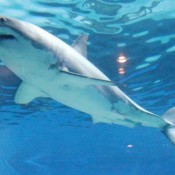
January 7 and 8, 2016 Ryukyu Shimpo
A great white shark has been exhibited in Okinawa Churaumi Aquarium. Great white sharks account for the largest number of shark attacks against humans and also appeared in the American film “Jaws”.
The shark was a male about 3.5-meter long and was caught in a fixed fishing net set by the Yomitan Fisheries Cooperative Association on January 4. It was brought to Okinawa Churaumi Aquarium on January 5. According to the aquarium, there are several cases of captive juvenile great white sharks but this was the first time in the world to keep an adult in an aquarium. Okinawa Churaumi Aquarium was the only facility in the world to have a great white shark at this time.
Masanori Nonaka, a team leader at the Aquarium said, “Keeping records for the shark are limited throughout the world so biological detail is not known. We wish to obtain important records by looking after the shark.”
A great white shark had been kept in captivity in Monterey Bay Aquarium, the United States, for a few months, and in Shimane Aquarium, Japan for only four days. These sharks were a little over one-meter long. A great white shark is very difficult to transport and keep in captivity because it needs to keep moving in the sea to survive.
(English translation by T&CT, Hitomi Shinzato)
Go to Japanese
Death of the shark under investigation
According to the aquarium, the great white shark died on the morning of January 8. It was for three days that the shark survived in captivity at the aquarium. The shark was in a stable condition enough to swim on January 8. But, during the morning of January 8, the animal’s condition worsened abruptly. It was unable to swim and was lying on the floor of the tank. Staff and a veterinarian moved the shark into another tank for treatment, but the rescue efforts could not save it. At 9:32 a.m. on January 8, the death of the shark was confirmed. The aquarium is investigating the cause of the death.
“It’s very regrettable,” a public affairs spokesperson at the aquarium said. “Many people visited to see the great white shark. We would like to collect data from the body, which will help keeping great white sharks in the future.”
(English translation by T&CT)
Go to Japanese

A 3.5-meter long male great white shark was exhibited at Okinawa Churaumi Aquarium in Motobu on January 6.
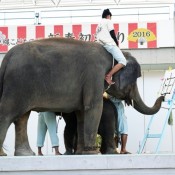
January 11, 2016 Ryukyu Shimpo
On January 2 and 3, a New Year’s Festival was held at the Okinawa Zoo & Museum in the Goya district of Okinawa City. Along with her daughter Rubi, who was born in 2015, popular Indian elephant Ryuka appeared in public and performed kakizome, or the first calligraphy of the year. She dexterously wrote “monkey”, this year’s Chinese zodiac sign, in kanji, entertaining the spectators.
An event in which monkey took over from sheep, last year’s Chinese zodiac sign, was held. Primates slow loris Hina and Arare received a sash, which made the audience let out a cheer.
An exhibition about monkey’ the zodiac sign will be held in a special gallery until January 31.
(English translation by T&CT)
Go to Japanese












 Webcam(Kokusai Street)
Webcam(Kokusai Street)


